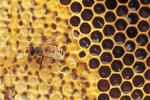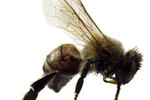
Every honey bee (Apis mellifera) in a hive exists to perform specific duties determined by their gender and age. Like every member of its colony, the nurse honey bee plays a vital role in the survival of its hive. Nurse bees are charged with the care and feeding of the queen and the next generation.
Eggs
Eggs are laid by only one member of the hive, the queen. She may lay as many as 1,500 every day through the spring and summer months. Nurse bees carry the eggs to individual cells in the honeycomb where they gestate for three to four days before hatching.
Larvae
Once the eggs hatch, the nurse bees devote themselves to the care of the larvae. They feed them bee bread, a combination of honey, pollen and royal jelly, a secretion from the nurse honey bees' salivary glands. The larvae are fed for three to four days, at which point the nurse bees seal the cells with wax. After 10 days adult bees emerge from the cells.
Adults
The vast majority of the newly emerged bees are sterile females, the rest are drones and potential queens. Drones are responsible for guarding the nest and if necessary, mating with the queen. In the fall they are driven out of the hive to die in the elements. If the queen is still capable of producing fertilized eggs, the fertile females are forced out of the hive soon after they emerge from their cells. If the queen is no longer viable, the strongest of the new fertile females drives both the other fertile females and the current queen away and assumes the role of queen.
Worker Bees
The sterile females, or worker bees, make up, by far, the largest percentage of bees in a hive. While there are 200 to 300 drones and only one queen at any given time, there may be as many as 80,000 worker bees in a thriving hive. Worker bees begin their lives as nurse bees. They spend the first week after they emerge from their cells caring for and cleaning up after the queen, feeding the larvae and making honey. From there the nurse honey bees graduate to a maintenance crew. For the next week or two the worker bees care for the hive itself by making wax and building honeycomb, ventilating the hive by fanning the entrance with their wings and repairing any damage done to the interior of the hive. By the time they are about 3 weeks old the worker bees are ready to venture out of the safety of the hive. They will spend the rest of their lives, only about three weeks, gathering pollen and nectar for the colony.
References
Photo Credits
-
Photos.com/Photos.com/Getty Images
Writer Bio
Barbara Taliaferro is an animal enthusiast who lives in Ambler, Pa. She holds a Bachelor's Degree in Animal Science and has spent most of her life working with animals and the people who love them. She has been sharing her love and knowledge of animals through the written word since 2009.




